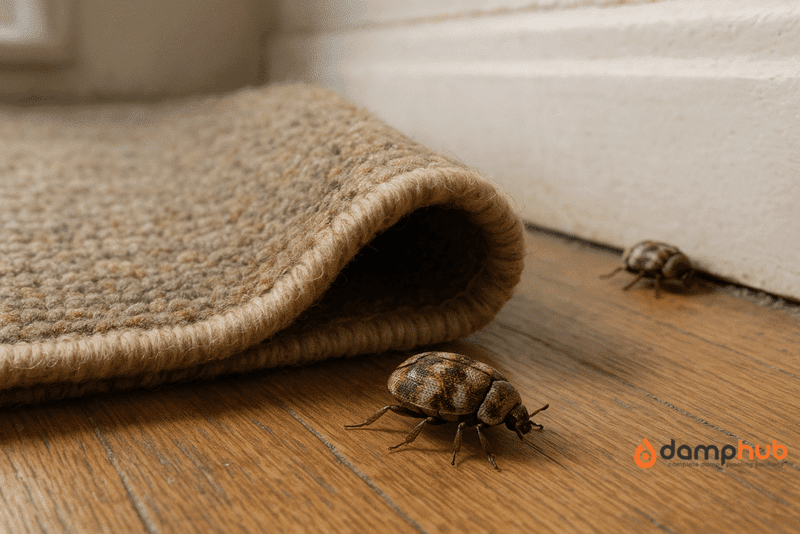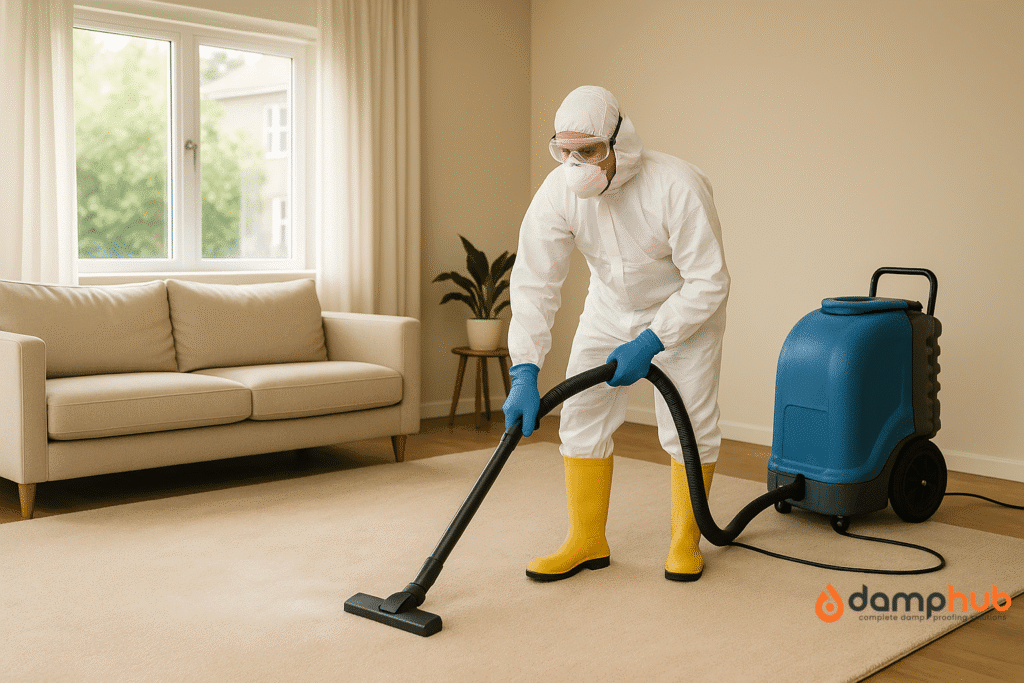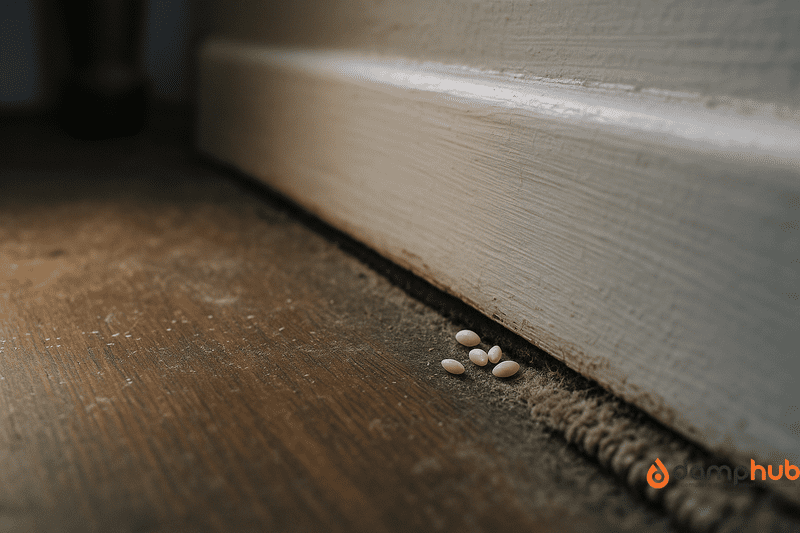
Ever pulled out a favourite jumper and found holes that weren’t there before? Or noticed strange, threadbare patches on a rug that looked perfectly fine last month?
That’s probably not just wear and tear. Chances are, you’ve got company—and not the kind you can kindly show the door.
Carpet beetles have quietly become the UK’s most destructive textile pests.
According to the British Pest Control Association (BPCA), their larvae have now overtaken clothes moths as the main cause of damage in homes, attacking everything from soft furnishings to sentimental keepsakes.
The problem? Many people still mistake them for moths, only realising the truth when the damage is done.
Knowing what carpet beetles look like, how they sneak in, and where they hide can help you stop them early.
This guide covers it all—from spotting the signs to getting rid of carpet beetles properly and keeping them out for good.
What Do Carpet Beetles Look Like?
They’re small. Really small. You could go years without noticing them until something expensive gets chewed through.
There are three main types found in the UK:
- Varied Carpet Beetle – Oval-shaped and tiny (2 to 3.5 mm), with a speckled mix of brown, white, and yellow. Looks almost like a mini ladybird. Read Our Full Guide👉: What Is a Varied Carpet Beetle?
- Black Carpet Beetle – A bit longer, and solid black or dark brown. They’re not flashy — just destructive. Read more here: 👉 How to Identify and Get Rid of Black Carpet Beetles
- Furniture Carpet Beetle – Rounder body, mottled like the varied kind, but with duller tones.
Then there’s the real headache: the larvae. Also called woolly bears, these bristly little crawlers are brown and hairy, and they’ll roll up defensively when touched.
You’ll often find their shed skins before you see the bugs themselves — like lint or dust, except it’s alive… or was.
Must Read: What Is the Woolly Bear Carpet Beetle?
.
Where Do Carpet Beetles Come From?
It’s not your fault. Carpet beetles are opportunists. Most of the time, they’re brought in by accident.
Common ways they sneak in:
- Through open windows and doors in summer, they’re drawn to light
- On second-hand furniture, especially upholstered pieces
- Hidden in old clothes or blankets picked up from car boot sales or charity shops
- On fresh flowers from the garden
- From bird nests in your loft or eaves
Once inside, the adults lay eggs in quiet spots full of “food”, meaning anything made of natural fibres. You won’t notice them until the larvae are halfway through your winter coat.
More help here: How to Prevent Carpet Beetle Infestation
Where Do Carpet Beetles Hide in the House?

Out of sight, out of mind — that’s their survival strategy.
They go where you rarely clean:
- Under heavy rugs and along carpet edges
- In wardrobes full of wool, leather, feathers
- Behind the furniture you never bother to move
- Inside boxes in the loft or a cupboard under the stairs
- In air vents, attics, and ceiling voids
- Inside lampshades or old books
They like undisturbed areas with natural fibres. Even clean homes can become infested — if the beetles find a quiet corner with the right conditions, they’ll set up shop.
Compare pests: Carpet Beetle Larvae vs Bed Bug: How to Spot the Difference
How Damaging Are Carpet Beetles?
You won’t hear them. You probably won’t see them either. But your fabrics will tell the story.
Carpet beetle larvae nibble away slowly but steadily. A scarf stored away for winter might come out riddled with holes. Cushions, curtains, and even soft toys can get hit.
Common signs:
- Irregular holes in clothes, rugs, or upholstery
- Crumbly skins that look like dust
- Droppings that look like pepper grains
- Bald patches on wool rugs
- Skin irritation from the hairs of larvae (they’re bristly)
If you’ve got vintage or delicate items in storage, check them now — some infestations go unnoticed for years.
Get More info: How to Treat Carpet Beetle Rash
Our other guide👉 How to Prevent Carpet Beetle Bites?
How Long Do Carpet Beetles Live?
A single female carpet beetle can lay up to 100 eggs. And with the right conditions? That’s enough to kick off an infestation that lasts over a year.
Here’s their timeline:
- Eggs: Hatch within 1–3 weeks
- Larvae: Live for 6–12 months, feeding on your things
- Pupae: Develop for a few weeks
- Adults: Live 2–6 weeks (long enough to mate and lay more eggs)
This cycle overlaps. While one group is hatching, another is feeding, and another is breeding. Unless you interrupt the cycle, they’ll just keep coming.
How Do You Know If You Have Carpet Beetles?
Don’t wait for holes to appear. If you’re spotting any of the following, check for beetles:
- Mysterious fluff that turns out to be larval skins
- Beetles crawling near window frames
- Strange bite-like rashes (from hairs, not actual bites)
- Clothes that fall apart when picked up
- Musty smells in closed storage areas

Need some carpet beetle treatment? Read our full guide, How to Get Carpet Beetle Treatment (Without Making Things Worse)
How Do You Get Rid of Carpet Beetles Permanently?
This isn’t something you do once and forget about. Tackling carpet beetles properly takes a bit of determination — and a plan that hits every angle. Miss a step, and they’ll be back before you know it.
Here’s how to deal with them properly:
- Vacuum every day for at least two weeks. And not just the obvious bits — get right into the corners, behind radiators, under sofas, and inside wardrobes. You’re aiming to remove not just the bugs, but their eggs and the loose fibres they feed on.
- Steam clean anything soft. Carpets, curtains, sofas, pet beds — anything made of fabric needs a deep steam. The heat gets into the fibres and kills off both larvae and eggs. Don’t have a steam cleaner? It’s worth hiring or borrowing one for a day.
- Wash everything you can at 60°C. High heat kills them off. For delicate items like wool or silks, seal them in a bag and pop them in the freezer for three days. Both heat and cold do the trick — just make sure you’re thorough.
- Use a residual insecticide. Look for one that’s specifically made for carpet beetles. Spray around the edges of each room, behind furniture, inside cupboards, under rugs — anywhere they might be hiding. Use a nozzle if needed to get right into the gaps. Keep pets and kids away until everything’s dry.
- Dust with boric acid or diatomaceous earth. These natural powders are great for hidden areas — like floorboard gaps, air vents, and the edges of skirting boards. Leave it overnight, then vacuum it up the next day. It’s safe if used correctly, but deadly to beetles.
- Repeat all of this once a week for at least a month. Carpet beetle eggs don’t all hatch at once, so unless you keep at it, new ones will just take over where the last ones left off.
Need product suggestions? 10 Best Carpet Beetle Sprays to Buy in the UK (That Actually Work)
How Can You Prevent Carpet Beetles in the Future?
Getting rid of them is one thing — keeping them out for good is another.
The secret? Make your home less inviting to them. It’s not about doing a one-off deep clean and calling it a day. You need habits that keep them from settling in again.
Here’s what works:
- Vacuum regularly — and don’t skip under the furniture. Carpet beetles love hidden, dusty corners. Move things around now and then and give those spaces a proper clean.

- Check stored clothes every so often. If you’ve got off-season clothes packed away, give them a quick look every few months. Rotate what’s stored, shake it out, and make sure nothing’s becoming a cosy beetle buffet.
- Ditch cardboard boxes for sealed plastic containers. Cardboard attracts pests. Use lidded plastic bins or vacuum bags for storage — they’re cleaner, safer, and last longer, too.
- Add natural repellents like cedar blocks or lavender sachets. They smell nice to us, but beetles can’t stand them. Tuck them into drawers, wardrobes, or storage bins for an extra layer of defence.
- Keep pet bedding clean. These areas are often overlooked, but they’re full of fibres and hair that beetle larvae love. A weekly wash helps keep things in check.
- Seal up the gaps. Cracks in windows, doors, vents, or floorboards can all be entry points. Mesh screens and a bit of sealant go a long way.
Are Carpet Beetles the Same as Bed Bugs?
Not even close.
People often confuse them, especially when they spot a rash.
| Feature | Carpet Beetles | Bed Bugs |
|---|---|---|
| Bite Humans? | No (hairs can irritate skin) | Yes (bite while you sleep) |
| Activity Time | Mostly daytime | Active at night |
| Appearance | Tiny beetles or fuzzy larvae | Flat, reddish insects |
| Hideouts | Carpets, lofts, wardrobes | Mattresses, bed frames |
| Food Source | Natural fibres, feathers, wool | Your blood |
When Should You Call a Professional?
If you’ve cleaned, sprayed, and washed everything—and the beetles are still showing up—it’s probably time to call in the experts.
Professional pest controllers can:
- Track down hidden nests you’ve missed
- Use stronger, commercial-grade treatments
- Treat hard-to-reach areas like lofts, wall voids, and under floorboards
- Give proper advice on what’s salvageable and what needs to go
Not sure who to trust? The British Pest Control Association has a great video guide on choosing a professional pest controller, so you know you’re in safe hands.
Don’t feel bad: These beetles are persistent. But pros know exactly where they hide.
Final Tips for Dealing with Carpet Beetles
Disrupt their comfort. Bright light, frequent cleaning, and regular inspections make your home less appealing to them.
Need more help? Check our other guides on sprays, rashes, larvae removal, and carpet beetle bites for clear next steps.
Frequently Asked Questions About Black Carpet Beetles

-
How many carpet beetles is an infestation?
There’s no magic number — but if you’re spotting more than just the odd one, especially larvae in carpets or on clothes, it’s worth acting fast.
A single adult may have wandered in, but regular sightings or damage around the house mean they’ve likely settled in and started breeding.
-
What time of day are carpet beetles most active?
Adult carpet beetles tend to be more active during the day, especially in warm, sunny weather. You’ll often spot them near windows as they’re drawn to light.
The larvae, though, stay tucked away in dark places and feed quietly at any time, which is why they go unnoticed for so long.
-
How many eggs can a carpet beetle lay?
A female carpet beetle can lay around 40 to 100 eggs in one go — and she’ll tuck them away in hidden spots like carpets, furniture, or clothing.
That’s why a small problem can quickly grow if you don’t catch it early.
-
What are the stages of carpet beetles?
Carpet beetles go through four stages: egg, larva, pupa, and adult. It’s the larval stage that does the most damage, feeding on natural fibres like wool, silk, or feathers.
Once they pupate, they become adult beetles, which then fly off to find new places to lay eggs and start the cycle again.
-
Can carpet beetles cause swollen lymph nodes?
It’s rare, but a strong allergic reaction to carpet beetle larvae — particularly their hairs — could trigger swelling, including lymph nodes.
This isn’t typical, but if you’ve had a rash or reaction that spreads or feels more serious, it’s best to get it checked out by your GP.
-
Can carpet beetles cause a sore throat?
Not directly.
But in some people, especially those with allergies, the tiny hairs from carpet beetle larvae can irritate airways if disturbed, especially during vacuuming or cleaning.
This might lead to mild throat irritation or coughing, but it’s not a common symptom for most people.
-
Do carpet beetles have a smell?
Not really. Carpet beetles don’t give off a noticeable smell like some pests do.
But if you’ve got a large infestation — especially of larvae — you might pick up a musty or dusty scent from fabric damage or buildup in hidden areas.
It’s not strong, but in a closed room, you might notice it.
-
Can carpet beetles live in your bed?
They don’t live in beds like bed bugs do, but they might crawl across if you’ve got natural fibres in your bedding.
Wool blankets, feather duvets, or silk sheets can attract larvae if the infestation is bad.
You’re more likely to find them in carpets, wardrobes, or under furniture — but if you’re seeing larvae on your bed, it means they’re spreading.
-
How long does it take to get rid of carpet beetles?
It depends on how bad the infestation is. For light cases, a deep clean and a few targeted treatments might sort it out within a week or two.
For larger infestations — especially if eggs are hidden away — it can take a few months of repeated cleaning and treatments to fully break the cycle.
-
Will carpet beetles go away on their own?
Not likely. Even if the adults die off, their eggs and larvae will keep the problem going unless you treat it.
Ignoring them usually means they’ll spread, especially in warm weather.
A proper clean, plus vacuuming and washing fabrics, is essential to stop them coming back.
-
Can you see carpet beetle eggs?
Not easily. They’re tiny — usually less than 1mm — and white or cream-coloured.
Eggs are often laid in hidden places like under carpets, behind furniture, or in the folds of fabric.
Most people only realise they’re there when the larvae hatch and start feeding. 👉Read our full guide on how to identify and remove carpet beetle eggs.
-
Can I get rid of carpet beetles without a professional?
Yes — if you catch it early and clean thoroughly.
Vacuum every day for a while, wash affected fabrics on high heat, and treat problem areas with insecticide or diatomaceous earth.
For serious or recurring infestations, though, professional treatment is often the only way to fully clear out hidden eggs and larvae.
-
What spray kills carpet beetles?
Look for insect sprays that target crawling insects or say they’re effective against carpet beetles. In the UK, brands like Zero In, Rentokil, or PestShield do the job.
Make sure to get into cracks, carpet edges, and fabric folds — and always follow the safety instructions.
-
How often should I vacuum to get rid of carpet beetles?
Every day at first. Focus on the edges of carpets, under furniture, and around wardrobes.
Keep at it daily for a couple of weeks, especially if you’ve treated the area. After that, stay on top of it weekly to stop them from coming back.
-
What materials attract carpet beetles
Wool, silk, feathers, fur, leather — anything natural. They’ll also feed on lint, pet hair, dead insects, and even crumbs trapped in fabrics.
Synthetic materials like polyester are usually safe, but blends can still attract them if they contain natural fibres.






